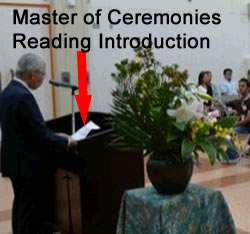Improve Your Speaking, Communicating, and Leadership Skills and Have Fun Too!
 The first 30 seconds before your speech begins are just as important as the first 30 seconds after you begin speaking. These 30 seconds set the stage for your audience for what they should be listening for and why they should spend their time listening to what you have to present.
The first 30 seconds before your speech begins are just as important as the first 30 seconds after you begin speaking. These 30 seconds set the stage for your audience for what they should be listening for and why they should spend their time listening to what you have to present.
At our Toastmasters club, we’ve been paying a bit more attention to those first 30 seconds lately. There are three parts to that time period before you deliver your first spoken word and I’d like to share what we’ve been covering lately.
- Learning Your Spot – I was speaking at a local university last week. The only place in the room where I could stand and have eye contact with my entire audience was behind a desk between two screens from floor to ceiling. This is a standing area that I’m not used to. So, about ten minutes before my speech, I walked to the front of the room to check it out and become comfortable with my positioning. Then I sat down to be introduced. Once introduced, I could enter the speaking area with confidence.
- Setup Everything in Advance – If you are speaking at your Toastmasters club, arrange with the Toastmaster of the Day or the Sergeant-at-Arms to help you setup your equipment and visual aids. This can happen before the meeting starts or before your introduction is read. If you are speaking outside your club for business or if you are a paid speaker, the same rule applies. Always arrive early and work out how your materials and tools for the presentation can be setup before your introduction is read. Waiting until after your introduction for this step kills all your momentum and excitement. You have to spend the first half of your presentation trying to get it back.
- Wait for Your Introduction to be Read – Yes, I did say “read.” Always prepare a short introduction of your presentation that the Toastmaster of the Day (or Master of Ceremonies at a professional event) can read your introduction to the audience. Good introductions are written so that they don’t seem to be written by the speaker. Take some time to prepare a good introduction and then strongly urge that the introduction is read word-for-word to introduce you.
One of the challenges we have as speakers is that we are always excited to get up on that stage. When your introduction is being read, try to be as silent and motionless as you can. Let the audience receive the words of the introduction. Avoid scooting your chair back and making a loud squeaking sound half-way through the introduction. Restrain yourself from walking to the front of the room while the words are being read. Wait until the audience begins their applause to welcome you so that you get the full effect of a well-constructed introduction—and, that benefit is a great kick-off to your presentation.
Now you can start your speech!

